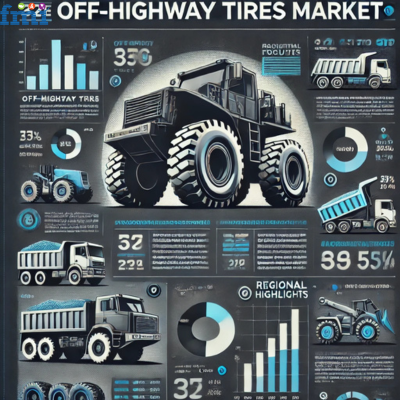
NEWARK, Del, Oct. 30, 2024 (GLOBE NEWSWIRE) -- Future Market Insights forecasts that the global off-highway tires market is expected to reach a valuation of USD 9,405.4 million in 2023, with a projected compound annual growth rate (CAGR) of 7.
9% from 2023 to 2033. By the end of 2023, the top three countries are anticipated to contribute approximately 25%-30% of the market share. Increasing demand for construction and material handling equipment, driven by growth in the construction sector across developing nations, is expected to significantly boost the off-highway tires market.
The rising adoption of off-road vehicles—such as cranes, wheel loaders, specialty vehicles, telescopic handlers, and tractors—is further fueling market expansion. Throughout the forecast period, the market's growth will be propelled by increased sales of off-road vehicles and advancements in farm mechanization. Additionally, the development of eco-friendly off-highway tires is expected to provide lucrative growth opportunities for the industry.
Understanding the Off Highway Tires Market The global off-highway tires market is poised for substantial growth, driven by rising demand in the construction and material handling sectors, especially in developing regions. Key countries are projected to hold a significant share of the market, influenced by the expansion of construction projects and industrial activity. The market is also benefiting from the increasing use of various off-road vehicles, including cranes, wheel loaders, specialty vehicles, telescopic handlers, and tractors, which are essential in both agricultural and industrial applications.
Additionally, the push for environmentally sustainable solutions is fostering innovation in off-highway tire designs, creating promising growth opportunities. Enhanced mechanization in farming and robust off-road vehicle sales further contribute to the market’s upward trajectory over the forecast period. “The Off-Highway Tires Market is poised for significant growth, driven by rising demand in construction, agriculture, and mining sectors.
As infrastructure projects expand and agricultural mechanization increases, the need for durable and high-performance tires is becoming more critical. Additionally, the industry's shift towards environmentally friendly solutions and innovative tire technologies is expected to enhance market dynamics and support sustainability efforts in various applications.”- says Nikhil Kaitwade , Associate Vice President at Future Market Insights (FMI).
Key Takeaways for the Off-Highway Tires Market: Strong Market Growth : The off-highway tires market is projected to experience robust growth, driven by demand across the construction, agriculture, and industrial sectors, particularly in developing regions. Top Markets Leading the Demand : Key countries are expected to account for a significant portion of the global market share, supported by infrastructure development and the expansion of large-scale projects. Increasing Off-Road Vehicle Adoption : The rising use of off-road vehicles—including cranes, wheel loaders, specialized vehicles, telescopic handlers, and tractors—is a significant driver, as these vehicles are crucial to industries requiring heavy-duty, all-terrain capabilities.
Farm Mechanization Boost : Mechanization in agriculture, along with the adoption of advanced farming equipment, is propelling demand for high-performance off-highway tires that support rugged field conditions. Shift to Eco-Friendly Tires : The development of environmentally sustainable off-highway tires is gaining traction, addressing rising environmental concerns and offering new growth opportunities in the market. Technological Advancements : Advancements in tire design, including improved durability and enhanced traction features, are meeting the diverse needs of construction and material handling applications, further stimulating market growth.
Long-Term Opportunities : With continuous investment in infrastructure and sustainable technologies, the market is positioned for long-term growth, with manufacturers innovating to meet the evolving demands of both developed and emerging economies. Prominent Drivers of the Off-Highway Tires market: Infrastructure Development : Rapid urbanization and expanding infrastructure projects, particularly in emerging economies, are increasing the demand for off-road vehicles and machinery, thus fueling the need for off-highway tires. Agricultural Mechanization : The growing trend of farm mechanization to improve agricultural productivity is boosting demand for high-performance off-highway tires that can handle rigorous field conditions.
Rise in Construction Activities : A surge in construction activities, including road building and large-scale commercial projects, has created strong demand for construction equipment that relies on durable, all-terrain tires. Growth in Mining and Material Handling : The mining and material handling sectors, which require specialized vehicles with high traction and load-bearing capacities, are significantly contributing to market expansion. Adoption of Environmentally Friendly Tires : Increasing environmental awareness is driving manufacturers to develop eco-friendly off-highway tires, which support the sustainability goals of industries using off-road equipment.
Technological Innovations : Advancements in tire materials, tread designs, and durability features are enhancing tire performance, longevity, and safety, aligning with the heavy-duty requirements of off-road vehicles. Increased Demand for Specialty Vehicles : Rising usage of specialty vehicles such as telescopic handlers and wheel loaders across industrial sectors is also a notable driver, as these vehicles depend on robust tires to navigate challenging terrains. Challenges Faced by the Off-Highway Tires Market: Volatility in Raw Material Prices : Fluctuations in the cost of raw materials, such as rubber and petroleum-based products, can increase production expenses and impact profitability for manufacturers.
High Maintenance and Replacement Costs : Off-highway tires are subject to extreme wear due to heavy loads and rugged terrains, leading to frequent maintenance and replacements, which can be costly for end-users. Environmental Regulations : Stricter environmental regulations around emissions and waste disposal are pressuring manufacturers to develop eco-friendly tires, which can be cost-intensive and require R&D investments. Supply Chain Disruptions : Global supply chain challenges, such as transportation delays and shortages of critical components, can impact the timely availability of off-highway tires, affecting both production and end-user operations.
Market Competition : The presence of numerous players in the market drives competition, which can compress margins and challenge smaller companies in maintaining profitability. Lack of Skilled Operators : The need for skilled operators to handle complex off-road machinery is a barrier, especially in developing regions, as improper usage can lead to quicker wear and tear of tires. Technological Adaptation in Emerging Markets : While advanced tire technology is beneficial, its adoption in emerging markets can be slower due to higher costs and limited access to innovative solutions, impacting overall market growth in those regions.
Comprehensive Market Insights: Full Report Overview https://www.futuremarketinsights.com/reports/off-highway-tires-market Market Competition Key players operating in the Off Highway Tires market are MICHELIN, Continental AG, Bridgestone, The Goodyear Tire and Rubber Company, TOYO TIRE and RUBBER, JK TYRE and others.
Key manufacturers are increasing their regional market and building direct presence in local markets through mergers and acquisitions with local suppliers, as well as expanding their dealer network around prospective high demand locations. Also, manufacturers producing model-specific tires. Regional Analysis for the Off-Highway Tires Market: North America : Driven by extensive infrastructure projects and well-established agricultural and mining sectors, the region has high demand for durable, all-terrain tires for various off-road applications.
Europe : Environmental regulations and technological advancements drive demand for sustainable, high-performance off-highway tires, with significant growth from the construction and agricultural sectors. Asia-Pacific : Rapid urbanization, infrastructure development, and mechanization in agriculture make this the fastest-growing market, particularly in China, India, and Southeast Asia. Latin America : Growth in mining activities, especially in Brazil and Chile, along with agricultural expansion, supports demand for heavy-duty off-highway tires in the region.
Middle East & Africa : Infrastructure projects and mining activities, especially in South Africa and the GCC countries, are primary drivers, though the market faces challenges due to limited access to advanced tire technologies. Key Segments Profiled in the Off Highway Tires Market By Sales Channel, Off Highway Tires Market is segmented as: Replacement Tires OEM By End Use, Off Highway Tires Market is segmented as: Industrial Agriculture Mining Construction By Region, Off Highway Tires Market is segmented as: North America Latin America Eastern Europe Western Europe East Asia South Asia and Pacific Central Asia Russia & Belarus Balkan & Baltic Countries The Middle East and Africa German Translation Future Market Insights prognostiziert, dass der globale Markt für Off-Highway-Reifen im Jahr 2023 einen Wert von 9.405,4 Millionen USD erreichen wird, mit einer prognostizierten durchschnittlichen jährlichen Wachstumsrate (CAGR) von 7,9 % von 2023 bis 2033.
Bis Ende 2023 werden die drei größten Länder voraussichtlich etwa 25–30 % des Marktanteils ausmachen. Die steigende Nachfrage nach Bau- und Materialtransportmaschinen, die durch das Wachstum des Bausektors in den Entwicklungsländern angetrieben wird, wird den Markt für Off-Highway-Reifen voraussichtlich deutlich ankurbeln. Die zunehmende Verbreitung von Geländefahrzeugen – wie Kränen, Radladern, Spezialfahrzeugen, Teleskopladern und Traktoren – treibt die Marktexpansion weiter voran.
Während des gesamten Prognosezeitraums wird das Marktwachstum durch den steigenden Absatz von Geländefahrzeugen und Fortschritte bei der Mechanisierung der Landwirtschaft vorangetrieben. Darüber hinaus wird erwartet, dass die Entwicklung umweltfreundlicher Geländereifen der Branche lukrative Wachstumschancen bietet. Den Markt für Off-Highway-Reifen verstehen Der globale Markt für Off-Highway-Reifen steht vor einem erheblichen Wachstum, angetrieben durch die steigende Nachfrage in den Bereichen Bau und Materialtransport, insbesondere in Entwicklungsregionen.
Wichtige Länder werden voraussichtlich einen erheblichen Marktanteil halten, beeinflusst durch die Ausweitung von Bauprojekten und Industrieaktivitäten. Der Markt profitiert auch von der zunehmenden Nutzung verschiedener Geländefahrzeuge, darunter Kräne, Radlader, Spezialfahrzeuge, Teleskoplader und Traktoren, die sowohl in der Landwirtschaft als auch in der Industrie unverzichtbar sind. Darüber hinaus fördert der Vorstoß für umweltverträgliche Lösungen Innovationen bei der Konstruktion von Off-Highway-Reifen und schafft vielversprechende Wachstumschancen.
Die zunehmende Mechanisierung in der Landwirtschaft und der robuste Absatz von Geländefahrzeugen tragen im Prognosezeitraum weiter zum Aufwärtstrend des Marktes bei. Wichtige Erkenntnisse für den Markt für Off-Highway-Reifen: Starkes Marktwachstum : Für den Markt für Off-Highway-Reifen wird ein robustes Wachstum erwartet, das durch die Nachfrage in den Bereichen Bau, Landwirtschaft und Industrie, insbesondere in den Entwicklungsregionen, angetrieben wird. Top-Märkte mit der höchsten Nachfrage : Es wird erwartet, dass Schlüsselländer einen erheblichen Teil des globalen Marktanteils erringen werden, unterstützt durch den Ausbau der Infrastruktur und die Ausweitung von Großprojekten.
Zunehmende Nutzung von Geländefahrzeugen : Die zunehmende Verwendung von Geländefahrzeugen – darunter Kräne, Radlader, Spezialfahrzeuge, Teleskoplader und Traktoren – ist ein wichtiger Treiber, da diese Fahrzeuge für Branchen von entscheidender Bedeutung sind, in denen schwere Geländefahrzeuge erforderlich sind. Förderung der Mechanisierung in der Landwirtschaft : Die Mechanisierung in der Landwirtschaft sowie der Einsatz moderner landwirtschaftlicher Geräte treiben die Nachfrage nach Hochleistungsreifen für den Geländeeinsatz in die Höhe, die den rauen Bedingungen im Feld standhalten. Umstellung auf umweltfreundliche Reifen : Die Entwicklung ökologisch nachhaltiger Off-Highway-Reifen gewinnt an Bedeutung, trägt den zunehmenden Umweltbedenken Rechnung und bietet neue Wachstumschancen auf dem Markt.
Technologische Fortschritte : Fortschritte im Reifendesign, einschließlich verbesserter Haltbarkeit und verbesserter Traktionseigenschaften, erfüllen die vielfältigen Anforderungen von Bau- und Materialtransportanwendungen und stimulieren das Marktwachstum weiter. Langfristige Chancen : Durch kontinuierliche Investitionen in die Infrastruktur und nachhaltige Technologien ist der Markt für langfristiges Wachstum positioniert und die Hersteller entwickeln Innovationen, um den steigenden Anforderungen sowohl der Industrie- als auch der Schwellenländer gerecht zu werden. Wichtige Treiber des Off-Highway-Reifenmarktes : Entwicklung der Infrastruktur : Die schnelle Urbanisierung und die Ausweitung von Infrastrukturprojekten, insbesondere in Schwellenländern, erhöhen die Nachfrage nach Geländefahrzeugen und -maschinen und steigern somit den Bedarf an Off-Highway-Reifen.
Mechanisierung der Landwirtschaft : Der wachsende Trend zur Mechanisierung der Landwirtschaft zur Verbesserung der landwirtschaftlichen Produktivität steigert die Nachfrage nach Hochleistungsreifen für den Geländeeinsatz, die den rauen Bedingungen im Feld standhalten. Anstieg der Bautätigkeit : Ein Anstieg der Bautätigkeit, einschließlich Straßenbau und großer kommerzieller Projekte, hat zu einer starken Nachfrage nach Baumaschinen geführt, die auf langlebige Geländereifen angewiesen sind. Wachstum im Bergbau und Materialumschlag : Die Sektoren Bergbau und Materialumschlag, die Spezialfahrzeuge mit hoher Zugkraft und Tragfähigkeit erfordern, tragen erheblich zur Marktexpansion bei.
Einführung umweltfreundlicher Reifen : Das zunehmende Umweltbewusstsein veranlasst Hersteller dazu, umweltfreundliche Offroad-Reifen zu entwickeln, die die Nachhaltigkeitsziele der Industrie unterstützen, die Offroad-Geräte nutzt. Technologische Innovationen : Fortschritte bei Reifenmaterialien, Profildesigns und Haltbarkeitsmerkmalen verbessern die Leistung, Langlebigkeit und Sicherheit der Reifen und passen sie an die hohen Anforderungen von Geländefahrzeugen an. Erhöhte Nachfrage nach Spezialfahrzeugen : Die zunehmende Nutzung von Spezialfahrzeugen wie Teleskopladern und Radladern in verschiedenen Industriezweigen ist ebenfalls ein wichtiger Treiber, da diese Fahrzeuge für die Fahrt durch anspruchsvolles Gelände robuste Reifen benötigen.
Herausforderungen für den Off-Highway-Reifenmarkt: Volatilität der Rohstoffpreise : Schwankungen bei den Kosten für Rohstoffe wie Gummi und Erdölprodukte können die Produktionskosten erhöhen und die Rentabilität der Hersteller beeinträchtigen. Hohe Wartungs- und Ersatzkosten : Off-Highway-Reifen unterliegen aufgrund schwerer Lasten und unebenem Gelände extremem Verschleiß, was zu häufigen Wartungs- und Ersatzarbeiten führt, die für den Endbenutzer kostspielig sein können. Umweltschutzbestimmungen : Strengere Umweltschutzbestimmungen hinsichtlich Emissionen und Abfallentsorgung zwingen die Hersteller zur Entwicklung umweltfreundlicher Reifen.
Dies kann jedoch kostenintensiv sein und Investitionen in Forschung und Entwicklung erfordern. Unterbrechungen der Lieferkette : Probleme in der globalen Lieferkette, wie beispielsweise Transportverzögerungen und Engpässe bei wichtigen Komponenten, können die rechtzeitige Verfügbarkeit von Off-Highway-Reifen beeinträchtigen und sowohl die Produktion als auch den Endverbraucherbetrieb beeinflussen. Marktwettbewerb : Die Präsenz zahlreicher Akteure auf dem Markt treibt den Wettbewerb an, der zu Margenverlusten führen kann und für kleinere Unternehmen eine Herausforderung darstellt, ihre Rentabilität aufrechtzuerhalten.
Mangel an qualifiziertem Bediener : Der Bedarf an qualifiziertem Bediener für die Bedienung komplexer Geländemaschinen stellt insbesondere in Entwicklungsregionen ein Hindernis dar, da eine unsachgemäße Verwendung zu einem schnelleren Reifenverschleiß führen kann. Technologische Anpassung in Schwellenmärkten : Fortschrittliche Reifentechnologie ist zwar von Vorteil, ihre Einführung in Schwellenmärkten kann jedoch aufgrund höherer Kosten und eines eingeschränkten Zugangs zu innovativen Lösungen langsamer erfolgen, was sich auf das allgemeine Marktwachstum in diesen Regionen auswirkt. Marktwettbewerb Wichtige Akteure auf dem Markt für Off-Highway-Reifen sind MICHELIN, Continental AG, Bridgestone, The Goodyear Tire and Rubber Company, TOYO TIRE and RUBBER, JK TYRE und andere.
Wichtige Hersteller erweitern ihren regionalen Markt und bauen durch Fusionen und Übernahmen mit lokalen Lieferanten eine direkte Präsenz auf lokalen Märkten auf. Zudem erweitern sie ihr Händlernetz um Standorte mit potenziell hoher Nachfrage. Außerdem produzieren Hersteller modellspezifische Reifen.
Regionale Analyse für den Off-Highway-Reifenmarkt: Nordamerika : Aufgrund umfangreicher Infrastrukturprojekte und eines gut etablierten Agrar- und Bergbausektors besteht in der Region eine hohe Nachfrage nach langlebigen Geländereifen für verschiedene Offroad-Anwendungen. Europa : Umweltschutzbestimmungen und technologische Fortschritte treiben die Nachfrage nach nachhaltigen, leistungsstarken Off-Highway-Reifen an, wobei das Bau- und Agrargewerbe einen erheblichen Zuwachs verzeichnet. Asien-Pazifik : Aufgrund der raschen Urbanisierung, der Entwicklung der Infrastruktur und der Mechanisierung der Landwirtschaft ist dies der am schnellsten wachsende Markt, insbesondere in China, Indien und Südostasien.
Lateinamerika : Das Wachstum im Bergbau, insbesondere in Brasilien und Chile, sowie die Expansion in der Landwirtschaft stützen die Nachfrage nach Hochleistungsreifen für den Off-Highway-Bereich in der Region. Naher Osten und Afrika : Infrastrukturprojekte und Bergbauaktivitäten, insbesondere in Südafrika und den GCC-Ländern, sind die Haupttreiber, obwohl der Markt aufgrund des eingeschränkten Zugangs zu fortschrittlichen Reifentechnologien vor Herausforderungen steht. Profilierte Schlüsselsegmente im Markt für Off-Highway-Reifen Nach Vertriebskanal ist der Markt für Off-Highway-Reifen wie folgt segmentiert: Ersatzreifen OEM Nach Endverbrauch ist der Markt für Off-Highway-Reifen wie folgt segmentiert: Industrie Landwirtschaft Bergbau Konstruktion Nach Regionen ist der Markt für Off-Highway-Reifen wie folgt segmentiert: Nordamerika Lateinamerika Osteuropa Westeuropa Ostasien Südasien und Pazifik Zentralasien Russland & Weißrussland Balkan und Baltikum Der Nahe Osten und Afrika Authored By: Nikhil Kaitwade (Associate Vice President at Future Market Insights, Inc.
) has over a decade of experience in market research and business consulting. He has successfully delivered 1500+ client assignments, predominantly in Automotive, Chemicals, Industrial Equipment, Oil & Gas, and Service industries. His core competency circles around developing research methodology, creating a unique analysis framework, statistical data models for pricing analysis, competition mapping, and market feasibility analysis.
His expertise also extends wide and beyond analysis, advising clients on identifying growth potential in established and niche market segments, investment/divestment decisions, and market entry decision-making. Nikhil holds an MBA degree in Marketing and IT and a Graduate in Mechanical Engineering. Nikhil has authored several publications and quoted in journals like EMS Now, EPR Magazine, and EE Times.
Have a Look at Related Research Reports of Automotive The global bicycle chain market size is projected to reach USD 7,610.2 million in 2024. It is estimated to surge at a CAGR of 4.
6% during the forecast period. The anticipated size of the global automotive wires market in 2022 was USD 4,823.2 million and is estimated to be USD 4,937 million in 2023.
The global automotive active safety system market size is anticipated to reach USD 45.69 billion by 2034. The global compact e-scooter market size is projected to reach USD 659.
8 million in 2024. It is anticipated to surge at a CAGR of 2.6% during the forecast period and is estimated to attain a value of USD 852.
9 million by 2034. The global automotive wiper blade market size is predicted to reach USD 5,962.8 million in 2024.
It is predicted to grow at a CAGR of 6.8% during the assessment period to reach a value of USD 11,505.9 million by 2034.
The global off-road all terrain e-scooter market size is projected to reach USD 1,713.4 million in 2024. It is anticipated to rise at a CAGR of 4.
8% during the forecast period and attain a value of USD 2,738.1 million by 2034. The global ambulance power inverter market size is anticipated to reach USD 73,229.
2 million in 2024. It is estimated to showcase a CAGR of around 5.7% in the forecast period 2024 to 2034, attaining a value of USD 127,477.
6 million in 2034. The global leisure boat market size is anticipated to reach USD 50,065.2 million in 2024.
It will likely broaden at a CAGR of 6.1% in the forecast period from 2024 to 2034. The demand for automotive interior leather is extensively increasing due to rising demand for vehicles with premium interior looks and flexibility among consumers in Korea.
The anticipated size of the automotive back-up camera market in 2022 was USD 292.7 million and is estimated to be USD 302.9 million in 2023.
About Future Market Insights (FMI) Future Market Insights, Inc. (ESOMAR certified, recipient of the Stevie Award, and a member of the Greater New York Chamber of Commerce) offers profound insights into the driving factors that are boosting demand in the market. FMI stands as the leading global provider of market intelligence, advisory services, consulting, and events for the Packaging, Food and Beverage, Consumer Technology, Healthcare, Industrial, and Chemicals markets.
With a vast team of 400 analysts worldwide, FMI provides global, regional, and local expertise on diverse domains and industry trends across more than 110 countries. Join us as we commemorate 10 years of delivering trusted market insights. Reflecting on a decade of achievements, we continue to lead with integrity, innovation, and expertise.
Contact Us: Future Market Insights Inc. Christiana Corporate, 200 Continental Drive, Suite 401, Newark, Delaware - 19713, USA T: +1-347-918-3531 For Sales Enquiries: [email protected] Website: https://www.
futuremarketinsights.com LinkedIn | Twitter | Blogs | YouTube.













